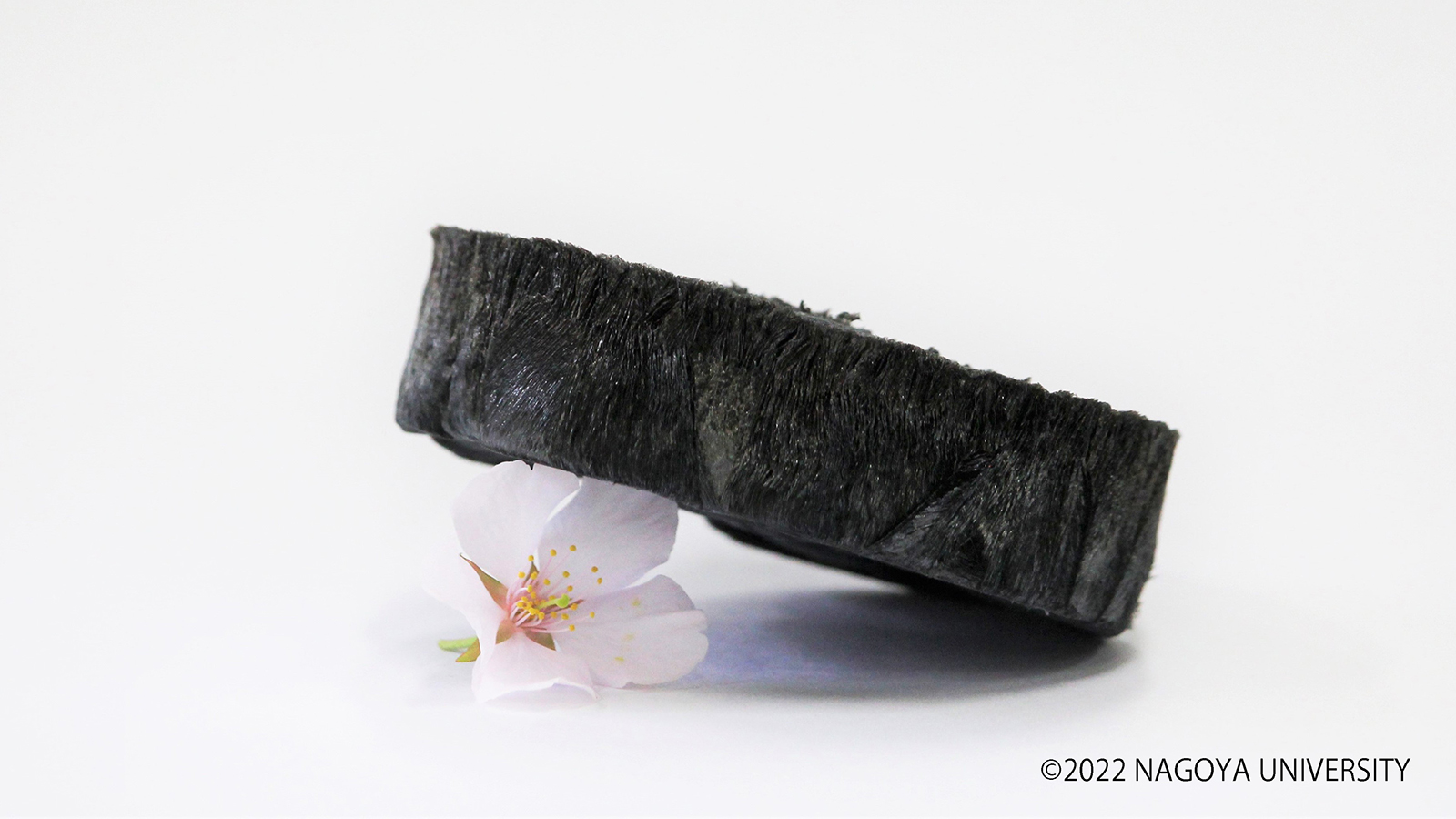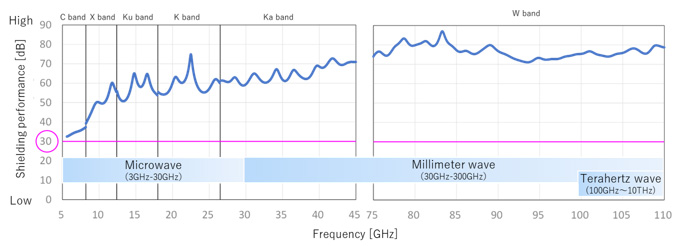
Dec 15, 2025
- Company
- Press Releases

Aug 25, 2022
Company / Press Releases
Selected as a Solution-creating Research project for the JAXA Space Exploration Innovation Hub Center
Ultra-light weight at 1/270 the bulk density of aluminum*1
Reduces weight in applications like spacecraft, eVTOL[1] vehicles, and 5G/6G base station
Osaka, Japan – Panasonic Industry Co., Ltd. (hereinafter referred to as Panasonic Industry) announced today that it has kicked off a joint research project on ultra-light EMC shielding material technology with the Japan Aerospace Exploration Agency, National Research and Development Agency (hereinafter referred to as JAXA). Designated as one of JAXA’s Solution-creating Research projects for space exploration, this effort is being undertaken in jointly with Nagoya University, Tokai National Higher Education and Research System, National University Corporation (hereinafter referred to as Nagoya University), Yamagata University, National University Corporation (hereinafter referred to as Yamagata University), and Akita University, National University Corporation (hereinafter referred to as Akita University), with Panasonic Industry serving as the representative organization.
Research is currently being conducted with the goal of reducing the weight of satellites used for space exploration through wireless in-flight communication and power supply which conventionally account for a significant percentage of their mass. To achieve this objective, advanced electromagnetic shielding technology is required to ensure electromagnetic compatibility (EMC).[2] Electric aircraft with lower environmental impact, such as drones and eVTOL vehicles that fly near the ground, also need both reduced weight and prevention against electromagnetic interference. Furthermore, as wireless communications such as 5G and 6G become faster and use higher frequencies, the need for electromagnetic shielding materials that are both lightweight and applicable to the millimeter-wave to terahertz-wave bands is expected to increase.
These four institutions began refining research on carbon nanotubes as an Idea-incubating Research*2 project through the JAXA Space Exploration Innovation Hub Center in 2020. To further develop the research, these four institutions were selected through a public call for the confirmation of participants for Step-up conducted by JAXA in 2021, and in June 2022, they started joint research on ultra-light electromagnetic shielding material technology.
This new ultra-light electromagnetic shielding material technology is expected to be widely adopted in fields like aerospace and next-generation high-speed communications in the future. By combining a unique resin formulation technology refined over many years with environmental testing capabilities and know-how that anticipate a variety of use cases on the ground, Panasonic Industry is aiming to commercialize the ultra-light EMC shielding material technology in 2024.
*1 The bulk density of the ultra-light EMC shielding material are roughly 0.01 g/cm3, compared to that of aluminum at 2.7 g/cm3.
*2 From January 2020 to March 2021, JAXA, Nagoya University, Yamagata University, Zeon Corporation, and Panasonic conducted joint research on an Idea-incubating Research project through the JAXA Space Exploration Innovation Hub Center. Since the goal of that research was achieved, this new joint research has been launched in June 2022 to take it to the next step as a Solution-creating Research project.

Table 1: Comparison of bulk densities between aluminum and the new materials
These new electromagnetic shielding materials were developed by bringing together ultra-light materials using carbon nanotube technology developed by Nagoya University and a thermosetting polymer formulation owned by Panasonic Industry. The new materials have electromagnetic shielding performance equivalent to that of aluminum at 1/270 its weight (with a bulk density[3] of roughly 0.01 g/cm3 level), making it ultra-light compared to commercially available electromagnetic shielding materials. These characteristics afford reduced weight in spacecraft and electric aircraft, which improves energy efficiency and helps extend flight range.

Graph 1: Electromagnetic shielding performance of the new materials
The new materials have high electromagnetic shielding performance exceeding 30 dB* in the wide frequency band from 5 to 110 GHz. Furthermore, they exhibit higher electromagnetic shielding performance at higher frequency bands.
* 30 dB = Level at which incident electromagnetic waves are shielded to 1/1,000 in terms of the power ratio (10 x log10 (1,000) = 30 dB)
The data shown here reflect measured values and do not guarantee performance.

Table 2: Comparison of applicable frequency bands for aluminum and the new materials
It is possible to configure the electromagnetic wave frequency band to be shielded according to the specifications of end-use devices by modifying the composition of these new materials,. The new materials achieve efficient electromagnetic shielding in increasingly diverse electromagnetic environments, preventing device malfunctions due to noise and facilitating EMC design.
Furthermore, unlike aluminum, the new materials have specific electromagnetic absorption capabilities that can prevent the reflected noise generated by devices themselves, including CPUs, and reduce deterioration of device characteristics deterioration due to noise superposition. In addition to these capabilities, the new materials also function across a wide range of frequency bands, therefore promoting the spread of next-generation wireless communication technology.
Three-dimensional structures can be created using Panasonic Industry's thermosetting resin formulation technology and freeze-drying manufacturing method,[4] making it possible to form these new materials into shapes customized to each device.
Spacecraft (satellites, probes, etc.), electric aircraft (drones, eVTOL vehicles, etc.), devices for 5G/6G applications (mobile base stations, etc.), industrial equipment (robots, AGVs, etc.), in-vehicle devices (millimeter-wave radar, various sensors, etc.), and VR/AR devices

The JAXA Space Exploration Innovation Hub Center was established in 2015 with the dual aims of advancing industries and creating new ones through the commercialization of innovative technologies on the ground and their eventual application in future space exploration. The Space Exploration Innovation Hub Center is committed to open innovation in research and development and solicits proposals for research projects on research topics set by JAXA based on technical information related to space exploration provided by researchers from companies, universities, research institutes, etc.
・Research theme: Development of ultra-lightweight material for electromagnetic shielding and absorption
・Period: June 2022 to June 2024 (24 months)
・Description: Conducting studies for commercializing ultra-lightweight electromagnetic shielding and absorbing materials

* ◎: Main research institute; 〇: Secondary research institute
Research items and roles of joint research members
[1] eVTOL
An Electric Vertical Take-Off and Landing (eVTOL) vehicle is a type of "flying car" capable of taking off and landing vertically, combining some of the characteristics of a helicopter, drone, or small airplane.
[2] EMC
Electromagnetic compatibility (EMC) is the capacity of electrical or electronic equipment to operate as intended without affecting surrounding devices with electromagnetic waves (electromagnetic noise), and without being affected by electromagnetic waves (noise) emitted by surrounding devices.
[3] Bulk density
Value obtained by dividing the weight of a sample by its volume including voids between particles.
[4] Freeze-drying method
Manufacturing method in which a sample containing moisture is placed in a vacuum freeze-dryer and rapidly frozen at about -30°C. After freezing, the chamber is further depressurized to create a vacuum whereby any moisture is sublimated to dry the sample.
September 18 to 22, 2022: IAC 2022 in France
November 1 to 4, 2022: 66th Space Sciences and Technology Conference in Kumamoto City
Research-related inquiries
Electronic Materials Business Division, Panasonic Industry Co., Ltd.
https://industrial.panasonic.com/cuif/ww/contact-us?field_contact_group=2343&field_contact_lineup=3803
Public Relations Department, Panasonic Industry Co., Ltd.
press-industry@ml.jp.panasonic.com
Nagoya University
Public Relations Office, Nagoya University, Tokai National Higher Education and Research System, National University Corporation
nu_research@adm.nagoya-u.ac.jp
Yamagata University
Public Relations Office, General Affairs Department, Yamagata University, National University Corporation
yu-koho@jm.kj.yamagata-u.ac.jp
Akita University
Public Relations Section, Akita University, National University Corporation
kouhou@jimu.akita-u.ac.jp
|
About Panasonic Industry Co., Ltd. A global leader in developing innovative technologies and solutions for wide-ranging applications, the Panasonic Group switched to an operating company system on April 1, 2022, with Panasonic Holdings Corporation serving as a holding company that has eight companies under its umbrella. Panasonic Industry, in charge of the Panasonic Group’s device business as one of the eight companies in the Group, was established on April 1, 2022 with the mission "We will open the way to a better future and continue to contribute to an affluent society through a variety of device technologies." Against the backdrop of the labor shortage in manufacturing, the explosion of data with the rise of the information-based society, and greater demands for the environment and safety for the mobility society, the company focuses on areas where continuous evolution is required and provides customer value with distinctive features of unique materials and process technologies such as capacitors, compact servomotors, EV relays, and electronic materials. For the year ended March 31, 2022, the company achieved net sales of 1,131.4 billion yen. To learn more about Panasonic Industry, please visit: https://www.panasonic.com/global/industry |
The content in this website is accurate at the time of publication but may be subject to change without notice.
Please note therefore that these documents may not always contain the most up-to-date information.
Please note that German, Spanish and Chinese versions are machine translations, so the quality and accuracy may vary.